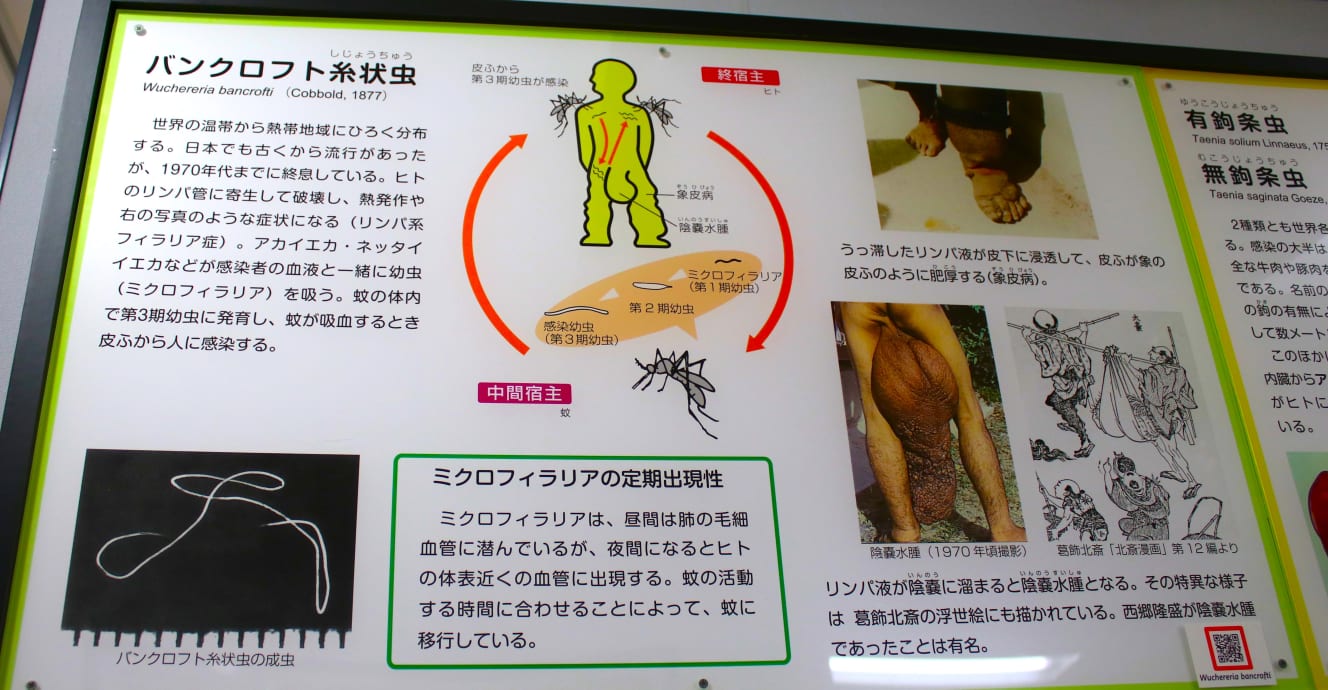Bill Gates Awe at the 8.8-Meter Tapeworm and the Meguro Parasite Museum Unveiling the Reality of Parasites
Grapes cultivation, a key industry in Yamanashi, was also triggered by parasite control.
Today, parasite damage has been greatly reduced, but this is due to the fact that in the past, the Japanese people faced parasites head-on and fought to suppress them. From here, let’s take a look at the records and achievements of the Japanese people in relation to parasites, along with the materials displayed on the second floor.
Bancroft’s Threadworm
Bancroft’s filariasis is a parasite that is widely distributed in temperate and tropical regions of the world and was once found in many parts of Japan. Bancroft’s filamentous worm was transmitted by mosquitoes, and by parasitizing the lymphatic system and stopping the flow of lymph, it caused elephantiasis, a thickening of the skin, and scrotal edema, a condition in which the skin accumulates in the scrotum. This condition was depicted in a work by Katsushika Hokusai and was called lymphatic filariasis.
The fight against filariasis in Japan took place in the 1950s and involved the use of DDT (*abbreviation for dichlorodiphenyl trichloroethane), which was used by the US military, and Spatonin (diethylcarbamazine citrate), developed by Tanabe Seiyaku as an anti-cirrhosis drug. This led to the implementation of a control program aimed at eradicating larvae-carrying mosquitoes and treating patients.
*DDT: A highly potent insecticide used by the U.S. military during World War II.
The cycle of infection is broken by repeating the process of killing the insects in the body with oral medication and eliminating the mosquitoes with DDT. The control of filariasis was successfully completed in the 1970s, and filariasis on Jeju Island, Korea, was also controlled through a joint Japan-Korea project.

Japanese blood fluke
Japanese schistosomiasis was a disease endemic to a limited area of Japan. The cause was a parasite found in the body of a cat in Yamanashi Prefecture in 1904. When parasitized, the eggs produced in the intestinal wall, liver, and other blood vessels of humans clog the blood vessels. Eventually, it causes stunting and poor growth, resulting in emaciation and eventually death.
Treatment was difficult, requiring more than two dozen intravenous injections, and the side effects of the drugs were significant. The drug was sprayed in rice paddies and rivers to eradicate the mussel, Mytilus galloprovincialis, which carried the Japanese blood sucking bug, but the toxicity of the drug was considered a problem, and the effort did not go as smoothly as expected.
In 1936, however, the biologist Masatoshi Iwata took up the challenge. Biologist Masatoshi Iwata proposed concreting waterways. The purpose was to speed up the flow of water and prevent miyairi mussels from reproducing.
In Yamanashi Prefecture, where the last of the infected remained, land was improved to control the mussels, and the rice paddies that had existed until then were converted to peach and grape orchards. The vineyards that have now become Yamanashi’s core industry are the result of the struggle between industry, academia, government, and the private sector and the parasite. It was only recently, in 1996, that Yamanashi Prefecture announced a “declaration of the end of the disease.

The number of cases of parasite infestation has been dramatically reduced thanks to postwar mass examinations and the educational and research activities of various organizations. On the other hand, there is a theory that the symptoms that appear when parasites invade the body vary from person to person, and this theory is still being debated and studied today.
Whether you are interested in the ecology of parasites or just want to be inspired by the great achievements of our predecessors who fought for Japan, why not stop by?